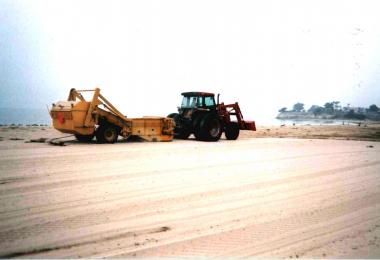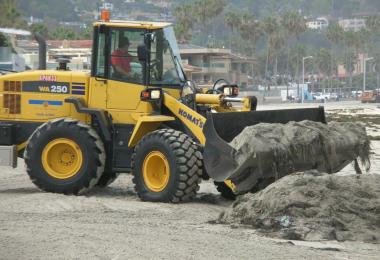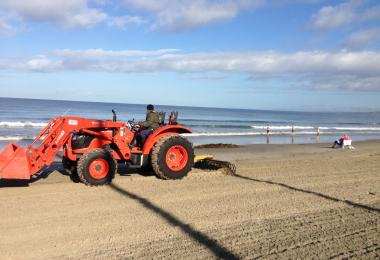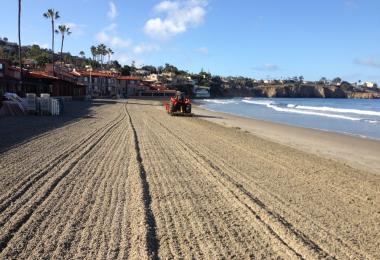Many miles of Southern California’s sandy beaches are maintained to meet visitors’ expectations of a "clean" beach. Behind the scenes, city and county beach management staff work, using a fleet of special machinery, to clear away not just trash and litter but, also, beach debris from natural sources. Wrack, shells, and driftwood are removed in a process is called beach grooming.
| Groomed Beach Characteristics | Natural Beach Characteristics |
| Kelp and seaweed wrack, along with other natural debris are removed mechanically | Kelp wrack accumulates on the beach and is removed only by invertebrates and natural processes |
| Little or no native plants or vegetation | High diversity of invertebrates |
| Low diversity of invertebrates | Wrack-associated animals are present |
| Few shorebirds | Many species of shorebirds |
| Beach lacks features such as hummocks (low mounds of sand formed by wind) and embryo dunes | Vegetation can take hold, such as sand-trapping coastal strand plants |
| Beach topography is varied and can feature hummocks and embryo dunes that trap and store sand |
Explore the interactive map to find a groomed or pristine beach near you!
While beach grooming can simply involve manually removing litter by hand, more commonly heavy equipment is used to remove litter, wrack, and debris from the broad expanses of Southern California beaches.
The photo below shows one type of mechanical grooming machine. This is a raking device dragged behind a dump truck that sifts and removes all debris from the sand. Loaders, rakes, sand sifters, and tractors also are used to remove debris, wrack, trash and sand from the beach.


In Southern California, it is estimated that 45% or over 100 miles of beaches are groomed regularly.
- Many popular Southern California beaches are groomed daily but some beaches are groomed twice a day.
- Beach grooming at many Southern California beaches began in the 1960s.
- On a beach south of the University of California, Santa Barbara, it was estimated that more than 4 tons (the weight of two cars) of fresh kelp is deposited on a mile of beach per day during the summer - just imagine the amount of kelp that can be removed from a groomed beach in a month!


Ecological and Physical Impacts
Beach grooming:
- Removes kelp wrack, an essential part of the beach ecosystem. Wrack provides habitat for a variety of small animals, which are food for shorebirds. Learn more about the effects of grooming on kelp wrack.
- Kills beachhoppers, isopods, and beetles that live in the sand and depend on wrack for food and shelter. These sand dwellers eat kelp and serve as natural "custodians" of the beach and provide an important food source for shorebirds.
- Can destroy snowy plover and killdeer nests and grunion eggs if grooming activities coincide with the breeding seasons.
- Kills seedlings and removes seeds of dune plants. This results in a loss of native plants and, consequently, loss of dune formation and coastal strand habitat.
- Prevents hummock and dune formation. Dunes and hummocks can increase the amount of sand stored on the shoreline that is available to buffer the beach during storms and high sea level.
- Reduces nutrient cycling back to the ocean from the breakdown of wrack.
- Diminishes prey resources for shorebirds such as black-bellied plovers, snowy plovers and marbled godwits.
From the Experts

Dennis Simmons
President
Beach Ecology Coalition and retired Beach Manager for the City of San Diego
“Beach maintenance needs to be performed with an understanding of the organisms living in the intertidal areas and their ties to migrating species that feed there and the times of the year they are present. That same maintenance also needs to take into account the needs of the organisms that utilize the same zones for their recreation as well as the significant economic impacts that coastal access has to local cities and counties.”


